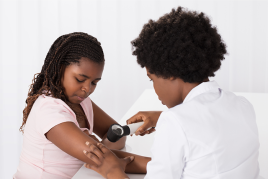Hiding child’s skin condition with makeup may boost self-esteem
If a birthmark or other skin condition causes your child to feel bad, covering it up with makeup may help. That’s what the findings from two studies suggest.
Camouflaging makeup can look natural
Covering up a skin condition with camouflaging makeup may improve a child’s quality of life.

Wearing makeup can improve a child’s quality of life
To find out whether having a skin condition can make children feel anxious, depressed, or withdrawn, researchers studied young patients at a dermatology clinic. Each child had an obvious birthmark, scar, or other skin condition. Their ages ranged from 5 to 18 years old.
The researchers found that most children felt bad because of their skin.
When a cosmetician covered each child’s scar or discoloration with camouflaging makeup, the children immediately felt better.
Overall, the children felt happier and more comfortable. Their self-confidence improved. Some kids said they felt normal. The children who had the poorest quality of life before wearing the makeup benefited the most.
Another study found similar results. In this study, the children’s ages ranged from 7 to 16 years old.
When a cosmetician covered each child’s birthmark, scar, or other skin condition with camouflaging makeup, these children felt better.
During this study, the researchers discovered that the children with obvious vitiligo felt irritable, worried, and embarrassed. They had difficulty making friends. The children with obvious acne scars felt embarrassed. They, too, found it hard to make friends.
Wearing a camouflaging makeup made them feel better. In a short time, their ability to make friends improved. They felt more comfortable.
Covering up with makeup is not right for every child
During these studies, the researchers also discovered that makeup isn’t the solution for every child.
One child who wore the makeup for a day never wore it again. However, knowing that this was an option left the child feeling more confident.
A few children stopped wearing the makeup after a while because it was too difficult to apply.
Choosing the right makeup is essential
If you’re tempted to run out and buy a cover-up stick for your child, keep reading.
The right makeup makes all the difference. You need to know which type of makeup will camouflage your child’s skin condition. A birthmark called a port-wine stain requires a different undertone than a birthmark known as café au lait spot.
It’s also important that you (or your child) learn how to apply the makeup so that it looks like the child’s own skin and not makeup.
And you want to choose makeup that is:
Waterproof
Going to last throughout the day
Non-comedogenic (won’t cause acne)
Non-allergenic (won’t cause an allergic skin reaction)
All these qualities are essential. Imagine how a child would feel if the makeup covering a port-wine stain drips off during gym class. Picture how other children would react if a child rubs her face, causing the makeup to come off and reveal a patch of vitiligo.
Seeking out a skilled cosmetician helps you get it right
A good way to find a skilled cosmetician is to ask your child’s dermatologist. You want to work with a cosmetician who has experience camouflaging birthmarks, scars, and other skin conditions.
Related AAD resources
Image
References
Tedeschi A, Dall'Oglio F, et al. “Corrective camouflage in pediatric dermatology.” Cutis 2007;79(2):110-2.
 Molluscum contagiosum: How to safely treat it
Molluscum contagiosum: How to safely treat it
 Biosimilars: 14 FAQs
Biosimilars: 14 FAQs
 Practice Safe Sun
Practice Safe Sun
 Relieve uncontrollably itchy skin
Relieve uncontrollably itchy skin
 Fade dark spots
Fade dark spots
 Untreatable razor bumps or acne?
Untreatable razor bumps or acne?
 Laser hair removal
Laser hair removal
 Scar treatment
Scar treatment
 Botox
Botox
 Free materials to help raise skin cancer awareness
Free materials to help raise skin cancer awareness
 Dermatologist-approved lesson plans, activities you can use
Dermatologist-approved lesson plans, activities you can use
 Find a Dermatologist
Find a Dermatologist
 What is a dermatologist?
What is a dermatologist?